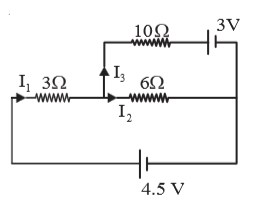In the equation I2+I−→,I−3 which is Lewis base
I2
I2
I−3
None of these
The correct Answer is:B
To determine which species is the Lewis base in the reaction I2+I−→I−3, we can follow these steps:
Step 1: Understand the Definition of Lewis Acid and Base
A Lewis base is defined as a species that can donate a pair of electrons, while a Lewis acid is a species that can accept a pair of electrons.
Hint: Remember that Lewis bases are electron pair donors.
Step 2: Identify the Reactants
In the given reaction, we have two reactants: I2 (iodine molecule) and I− (iodide ion).
Hint: Look at the structure of each reactant to determine their roles in the reaction.
Step 3: Analyze the Reaction
In the reaction, I− donates a pair of electrons to I2. This results in the formation of I−3. Here, I2 acts as an electron acceptor.
Hint: Identify which species is donating electrons and which is accepting them.
Step 4: Identify the Lewis Base
Since I− donates a pair of electrons to I2, I− is the Lewis base in this reaction.
Hint: The species that donates electrons is always the Lewis base.
Conclusion
Thus, in the reaction I2+I−→I−3, the Lewis base is I−.
Final Answer
The Lewis base in the equation is I−.
---
A Lewis base is defined as a species that can donate a pair of electrons, while a Lewis acid is a species that can accept a pair of electrons.
In the given reaction, we have two reactants: I2 (iodine molecule) and I− (iodide ion).
In the reaction, I− donates a pair of electrons to I2. This results in the formation of I−3. Here, I2 acts as an electron acceptor.
Since I− donates a pair of electrons to I2, I− is the Lewis base in this reaction.
Thus, in the reaction I2+I−→I−3, the Lewis base is I−.
The Lewis base in the equation is I−.
Topper's Solved these Questions
- IONIC EQUILIBRIUMBook:VMC MODULES ENGLISHChapter:IONIC EQUILIBRIUMExercise:LEVEL 2
Explore 50 Videos
- IONIC EQUILIBRIUMBook:VMC MODULES ENGLISHChapter:IONIC EQUILIBRIUMExercise:LEVEL 2 NUMERICAL VALUE TYPE
Explore 15 Videos
- IONIC EQUILIBRIUMBook:VMC MODULES ENGLISHChapter:IONIC EQUILIBRIUMExercise:IN - CHAPTER EXERCISE - K
Explore 10 Videos
- INTRODUCTION TO ORGANIC CHEMISTRY Book:VMC MODULES ENGLISHChapter:INTRODUCTION TO ORGANIC CHEMISTRY Exercise:JEE ADVANCED ARCHIVE
Explore 81 Videos
- JEE MAIN - 5Book:VMC MODULES ENGLISHChapter:JEE MAIN - 5Exercise:PART II : CHEMISTRY (SECTION - 2)
Explore 5 Videos
Similar Questions
Knowledge Check
In the reaction,
I2+2S2O2−3→2I−+S4O2−6.
AI2 is reducing agent.BI2 is oxidising agent and S2O2−3 is reducing agentCS2O2−3 is oxidising agent.DI2 is reducing agent and S2O2−3 is oxidising agent.
In the reaction SnCl4+2Cl−→[SnCl6]2− which is Lewis acid and which one is base?
View SolutionFind the standard electrode potential of I2∣2Ic− if the equilibrium constant for the reaction I2+Ic−→′(I3)c− is 703. The standard electrode potential of Ic−3∣3Ic− is 0.5355V. Also give the electrode reaction.
View SolutionIn the reaction I2+2OHΘ→IΘ+IOΘ+H2OI2 is
View SolutionΔH for the reaction, I(g)+I(g)→I2(g) will be :-
View SolutionStatement-1: I2+I→I3 in above reaction I2 is Lewis base and
Statement-2: Electron pair acceptor is Lewis base.
View SolutionRate constant for a reaction H2+I2→2HI is 49, then rate constant for reaction 2HI→H2+I2 is
View SolutionFind the current I1, I2, & I3, in the circuit.

View Solution

